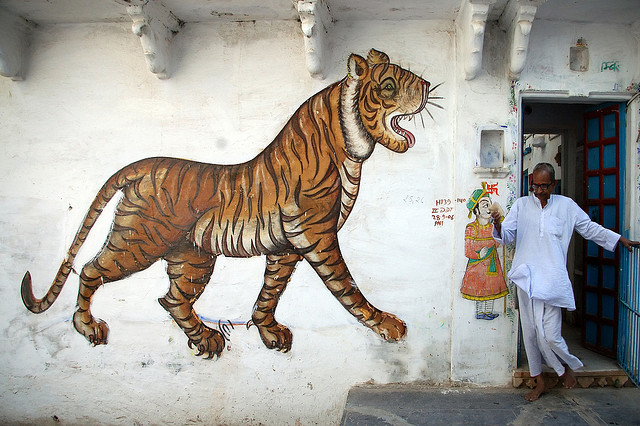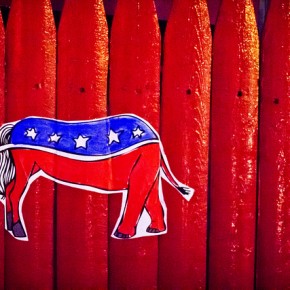In the early 1900s, there were more than 100,000 tigers worldwide, with the greatest number on the Indian sub-continent. In the twenty-first century, one country has overtaken India by having a larger tiger population than any other. The Humane Society of the United States reports that there are between 5000 and 7000 of the iconic big cats in the USA, but fewer than 400 of them are held in officially recognised zoos.
The great majority are kept as trophy pets-an absurd, if not obscene, example of profligacy in a capitalist society where the desire for status symbols has gone beyond Cadillacs, yachts and prize-winning pedigree dogs. A quick search on Google will take you to a website where you can buy a tiger online for US$13,400. A US-based charity, BigCatRescue, reckons that the set-up costs for accommodating a big cat are nearly $95,000 and annual expenses for food and other maintenance costs amount to at least $8000. 98% of exotic animals bought as pets die in the first two years.
By contrast, in their native homelands, tiger populations are in long-term decline. Three sub-species have gone extinct since 1940. The worldwide population in 1970 was 40,000 and had plummeted to 3200 in 2012 according to World Wildlife Fund (WWF) figures. India is where the tiger is thought to have the best chance of long-term survival, but even there, some experts have predicted virtual extinction of tigers in the wild by 2025.
Who should be blamed for this? Many would say it is the fault of the countries from where the tiger originates. But in the case of India, the government gave strong backing to Project Tiger as early as 1973. This put in place a plan that would protect the tiger’s habitat and outlaw poaching, envisaging a long-term future for the great predator.
China is often blamed for not doing enough to prevent the trade in tiger body parts. Rather than totally outlaw the trade, China licenses captive breeding programmes, and it is reckoned that between 4000 and 10,000 tigers are bred and maintained in this way in the People’s Republic.

But as far as we know, there are no examples of individuals in China owning any big cats as pets.
The tiger also has an iconic status in China, but it is highly endangered there. Reuters reported in 2010 that estimates from Chinese officials numbered no more than 50 in the whole country.
It is little more than coincidence that all three countries mentioned are three of the world’s major economic powers. So should Asian countries be doing better in conservation? After all, they should be looking after their own countries, why aren’t they looking after their flora and fauna?
I can hear many in the west cry, “the main problem is population growth!” Naturalists such as Chris Packham have lent their support to organisations such as Population Matters which aim to limit population growth so that we can save the planet and avoid a Malthusian apocalypse. If only countries like India controlled their population growth better! Couldn’t they be more like China, and stop their people breeding at such an alarming rate? After poaching, it is, after all, the loss of habitat that has led to so many magnificent beasts’ populations being reduced so drastically. Or the more liberal among us would say they should be encouraged to use contraception more, to be more like…well, us. Then they could reduce their population growth.
An article in The Guardian on 28th October carried the headline How to save the planet? Stop having children.’How convenient to be able to blame all those third world countries with high birth rates for messing up the planet. We can smugly sit in our centrally-heated homes, drive our 4x4s and take our annual fortnight holiday in Florida safe in the knowledge that we are doing our bit for the planet by not reproducing and paying a few extra quid to offset some of our carbon emissions. However, the headline was misleading. After mentioning the growth of Population Matters , which proposes means-testing for families with more than two children, it goes on to quote Jules Pretty, professor of environment and society at the University of Essex, as saying it is our consumption, not our procreation, which requires an adjustment.
This is not new, as anybody who’s studied geography over the fifteen years will be aware. As a support teacher, I have sat in on geography GCSE lessons in several secondary schools where the students are shown data that demonstrate how it is the developed world, with its insatiable lust for consumer goods, is exhausting the world of its resources. The World Wildlife Fund (WWF) published a report recently that detailed countries’ individual ecological footprints. Three oil-rich gulf states (Kuwait, Qatar and UAE) have the heaviest footprints, and the USA is eighth. Western governments tried to make political capital out of the fact that a few years ago China overtook the USA as the world’s biggest polluter; it is true that China now has 19% of the world’s ecological footprint compared to the USA’s 14%. India has roughly half of the USA’s share.
Yet, it doesn’t take a genius to work out that as both China and India have populations of over a billion each, their footprints per capita are much lower than that of the USA, and the vast majority of industrialised countries (China is 76th in the table, India doesn’t even appear in the top 100.)

Let there be no doubt that it is the world’s use of fossil fuels that has led to the huge increase in demands on the planet. The rise in exploitation of fishing grounds, water and agricultural land has been relatively small in the past fifty years, but our utilisation of carbon through burning fossil fuels has increased from 36% in 1961 to 53% in 2010.
The WWF’s report was unequivocal:
“The sum of all human demands no longer fits within what nature can renew. The consequences are diminished resource stocks and waste accumulating faster than it can be absorbed or recycled, such as with the growing carbon concentration in the atmosphere.”
As it posits itself as the model for all other nations, the US bears much of the responsibility for environmental degradation, largely because in the West, we have become so dependent on fossil fuels, but also because of the way our politicians’ desperation to follow American hegemony has led to an obsession with everybody needing to be a consumer, and those who don’t consume don’t count. Those at the bottom of society neither consume in adequate quantities nor do they vote, so it’s okay not just to marginalise them, but to demonise them. It’s considered acceptable to cut benefits, mock the poor in the media and perhaps most disgracefully of all, announce the withdrawal of support to international rescue teams in the Mediterranean in an effort to discourage migrants and refugees from coming to our shores. This is what the Conservative-LibDem Coalition government announced last week.
Similarly, but with more bloodlust, in Texas and the other states bordering Mexico, there are trigger-happy voluntary militias that patrol the border in an effort to stop people coming over the border.
“No more room!” They cry. “Our country has too many immigrants!”
Among at least 400 deaths of people attempting to cross the border every year, there have been several instances of shootings of Mexicans, mostly by vigilantes.
In Texas alone, there are more than 3000 big cats kept as pets. So far, none of them have been shot in the wild. The bigger question is how much longer will Americans (and by extension, most of us in the West) tolerate a situation where so many of them spend with such profligacy that they are more attentive to their own vanity than environmental degradation and suffering of people from nearby countries.
Photographs courtesy of Dave Morris, Bjorn Bulthuis, and Classic Film. Published under a Creative Commons license.





